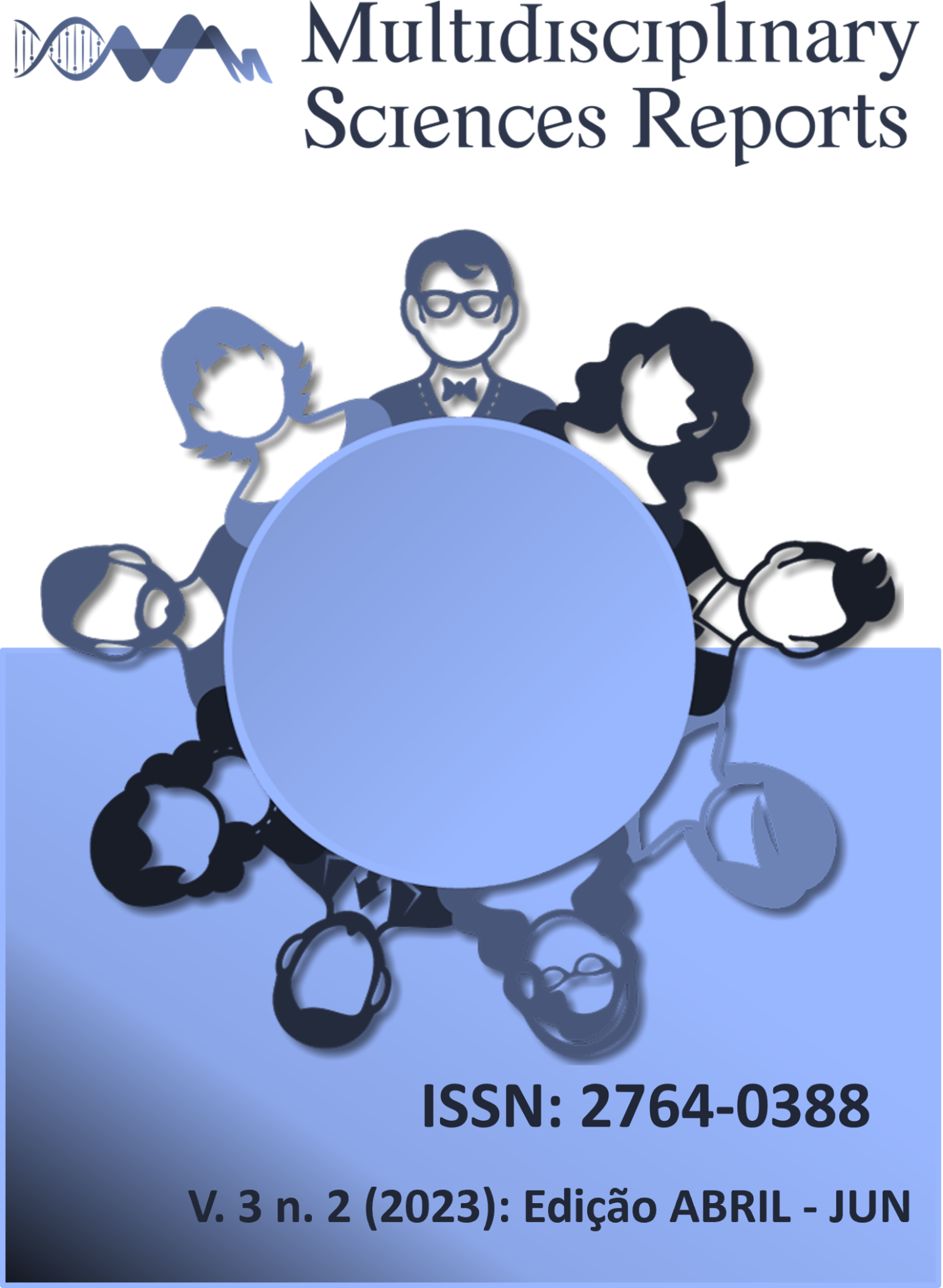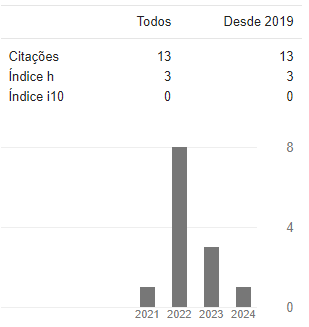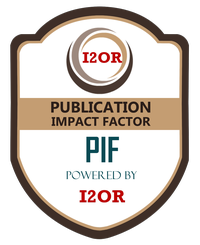Informações preliminares sobre a ação de produtos farmacêuticos não antibióticos na colonização de Pseudomonas aeruginosa TGC04
Visualizações: 253DOI:
https://doi.org/10.54038/ms.v3i2.37Palavras-chave:
Pseudomonadas, Produtos farmacêuticos não-antibióticos, Atividade antibiofilmeResumo
Moléculas com propriedades antimicrobianas, tais como os fármacos não-antibióticos, podem pressionar a adaptação de bactérias no ambiente. Nesse trabalho, cinco fármacos não-antibióticos mais vendidos no Brasil e no Egito em 2020 (losartan 50 mg, ácido acetilsalicílico 100 mg, diclofenaco sódico 50 mg, paracetamol 750 mg e metformina 500 mg e dipirona 100 mg/mL), foram testados contra a linhagem selvagem de Pseudomonas aeruginosa TGC04, isolada por nosso grupo e que vem sendo caracterizada ao longo dos anos. Nós avaliamos a inibição da adesão do biofilme durante 48 h, empregando o teste do cristal violeta. A exposição de P. aeruginosa TGC04 aos compostos promoveu uma redução moderada da adesão, semelhante, em todas as drogas testadas, perfazendo cerca de 60%. Isto indicou que as células também estavam moderadamente aderentes. Contudo, apesar de todos os fármacos não-antibióticos não terem produzido um efeito biocida à linhagem selvagem, foi observada uma alta atividade antibiofilme, com exceção do paracetamol.
Referências
Dar D, Dar N, Cai L, Newman D. Spatial transcriptomics of planktonic and sessile bacterial populations at single-cell resolution. Science 2021; 373 (6556): https://doi.org/ 10.1126/science.abi488. DOI: https://doi.org/10.1126/science.abi4882
Vasconcelos U, Das P, Dias DSB, Bonifácio TTC, Arruda RRA, Oliveira BTM, Cavalcanti TG. Mechanism of biofilm formation in Gram-negative bacteria. In: Mitra A. Micriobial biofilms: current research and practical applications. Caister Academic Press: Wymondham, p. 76-98, https://doi.org.10.21775/9781912530328.02.
Verderosa AD, Totsika M, Fairfull-Smith KE. Bacterial biofilm eradication agents: a current review. Front Chem 2019; 7: 824, https://doi.org/103389fchem.201900824. DOI: https://doi.org/10.3389/fchem.2019.00824
Santos ALS, Galdino ACM, Mello TP, Ramos LS, Branquinha MH, Bolognese AM, Columbano Neto J, Roudbary M. What are the advantages of living in Community? A microbial biofilm perspective. Mem Inst Oswaldo Cruz 2018; 13(9): e180212, https://doi.org.10.1590/0074-02760180212. DOI: https://doi.org/10.1590/0074-02760180212
Høiby N, Bjarnsholt T, Givskov M, Molin S, Ciofu O. Antibiotic resistance of bacterial biofilms. Int J Antimicrob Agents 2010; 35(4): 322-332. DOI: https://doi.org/10.1016/j.ijantimicag.2009.12.011
Oliveira ADL, Vasconcelos U, Calazans GMT. Detection of potential pathogenic Pseudomonas aeruginosa in a hospital water system. Res J Pharm Biol Chem Sci 2021; 12(4): 132-139.
Moradali MF, Ghods S, Rehm BH. Pseudomonas aeruginosa lifestyle: a paradigm for adaptation, survival, and persistence. Front Cell Infect Microbiol 2017; 7: 39, https://doi.org/10.3389/fcimb.2017.00039. DOI: https://doi.org/10.3389/fcimb.2017.00039
Subedi D, Vijay AK, Kohli GS, Rice SA, Willcox M. Comparative genomics of clinical strains of Pseudomonas aeruginosa strains isolated from different geographic sites. Sci Rep 2018; 8: 15668. https://doi.org/10.1038/s41598-018-34020-7. DOI: https://doi.org/10.1038/s41598-018-34020-7
Pirnay J-P, Bilocq F, Pot B, Cornelis P, Zizi M, Van Eldere J, Deschaght P, Vaneechoutte M, Jennes S, Pitt T, de Vos D. Pseudomonas aeruginosa population structure revisited. PloS One 2009; 4(11): e7740, htpps;//doi.org/10.1371/journal.pone.0007740. DOI: https://doi.org/10.1371/journal.pone.0007740
Norat CET, Pragana LG, Jaramillo LYA, Travassos RA, Vasconcelos U. Hydrocarbonoclastic activity in bacterial biofilms: A systematic study emphasizing pseudomonads. Conjecturas 2022; 22(12): 548-562. DOI: https://doi.org/10.53660/CONJ-1568-2D01
Nolan LM, Turnbull L, Katrib M, Osvath SR, Losa D, Lazenby JJ, Whitchurch CB. Pseudomonas aeruginosa is capable of natural transformation in biofilms. Microbiology 2020; 166(10): 995-1003. DOI: https://doi.org/10.1099/mic.0.000956
Anwar M, Iqbal Q, Saleem F. Improper disposal of unused antibiotics: an often overlooked driver of antimicrobial resistance. Expert Rev Anti Infect Ther 2020; 18(8): 697-699. DOI: https://doi.org/10.1080/14787210.2020.1754797
Borquaye LS, Ekuadzi E, Darko G, Ahor HS, Nsiah ST, Lartey JA, Mutala A-H, Boamah VE, Wood E. Occurrence of antibiotics and antibiotic-resistant bacteria in landfill sites in Kumasi, Ghana. J Chem 2019; 2019: 1-10, https://doi.org.10.1155/2019/6934507. DOI: https://doi.org/10.1155/2019/6934507
Wu D, Huang X-H, Sun J-Z, Graham DW, Xie B. Antibiotic resistance genes and associated microbial community conditions in aging landfill systems. Environ Sci Technol 2017; 51(21): 12859-12867. DOI: https://doi.org/10.1021/acs.est.7b03797
Yu Z, He P, Shao L, Zhang H, Lü F. Co-occurrence of mobile genetic elements and antibiotic resistance genes in municipal solid waste landfill leachates: A preliminary insight into the role of landfill age. Water Res 2016; 106: 583-592. DOI: https://doi.org/10.1016/j.watres.2016.10.042
Le Bastard Q, Berthelot L, Soulillou J-P, Montassier E. Impact of non-antibiotic drugs on the human intestinal microbiome. Expert Rev Mol Diagn 2021; 21(9): 911-924. DOI: https://doi.org/10.1080/14737159.2021.1952075
Kumar M, Sarma DK, Shubham S, Kumawat M, Verma V, Nina PB, Devraj JP, Kumar S, Singh B, Tiwari RR. Futuristic non-antibiotic therapies to combat antibiotic resistance: A review. Front Microbiol 2021; 12: 609459, https://doi.org.10.3389/fmicb.2021.609459. DOI: https://doi.org/10.3389/fmicb.2021.609459
Langadinou M, Onisor MO, Rigas A, Musetescu D-V, Gkentzi D, Assimakopoulos SF, Panos G, Marangos M. Antimicrobial properties on non-antibiotic drugs in the era of increased bacterial resistance. Antibiotics 2020; 9(3): 107, https://doi.org/10.3390/antibiotics90301072020. DOI: https://doi.org/10.3390/antibiotics9030107
Zimmermann P, Curtis N. Antimicrobial effects of antipyretics. Antimicrob Agents Chemother 2017; 61: e02268-16, https://doi.org. 10.1128/AAC.02268-16. DOI: https://doi.org/10.1128/AAC.02268-16
Lass-Flörl C, Dierich MP, Fuchs D, Semenitz E, Jenewein I, Ledochowski M. Antifungal properties of selective serotonin reuptake inhibitors against Aspergillus species in vitro. J Antimicrob Chemother 2001; 48: 775-779. DOI: https://doi.org/10.1093/jac/48.6.775
Ayaz M, Subhan F, Ahmed J, Khan A, Ullah F, Ullah I, Ali G, Syed N-i-H, Hussain S. Sertraline enhances the activity of antimicrobial agents against pathogens of clinical relevance. J Biol Res 2015; 22: 4, https://doi.org.10.1186/s40709-015-0028-1. DOI: https://doi.org/10.1186/s40709-015-0028-1
Wang Y, Lu J, Zhang S, Li J, Mao L, Yuan Z, Bond PL, Guo J. Non-antibiotic pharmaceuticals promote the transmission of multidrug resistance plasmids through intra- and intergenera conjugation. ISME J 2021; 15: 2493-2508 DOI: https://doi.org/10.1038/s41396-021-00945-7
Razavi B, FazlyBazzaz B. A review and new insights to antimicrobial action of local anesthetics. Eur J Clin Microbiol Infect Dis 2019; 38: 991-1002. DOI: https://doi.org/10.1007/s10096-018-03460-4
Laccellotti P. Antibacterial activity of ticagrelor in conventional antiplatelet dosages against antibiotic resistant Gram-positive bacteria. JAMA Cardiol 2019; 4: 596-599. DOI: https://doi.org/10.1001/jamacardio.2019.1189
El-Nakeeb M, Abou-Shleib H, Khalil A, Omar H, El-Halfawy O. In vitro antibacterial activity of some antihistaminics belonging to different groups against multi-drug resistant clinical isolates. Braz J Microbiol 2011; 42: 980-991. DOI: https://doi.org/10.1590/S1517-83822011000300018
Cooper R, Kirketerp-Møller K. Non-antibiotic antimicrobial interventions and antimicrobial stewardship in wound care. J Wound Care 2018; 27(6): 355-377. DOI: https://doi.org/10.12968/jowc.2018.27.6.355
Chang EWL, Yee ZY, Raja I, Yap JKY. Synergistic effect of non-steroidal anti-inflammatory drugs (NSAIDs) on antibacterial activity of cefuroxime and chloramphenicol against methicillin-resistant Staphylococcus aureus. J Global Antimicrob Resist 2017; 10: 70-74. DOI: https://doi.org/10.1016/j.jgar.2017.03.012
Tattawasart U, Maillard J-Y, Furr JR, Russell AD. Gjgg. Development of resistance to chlorhexidine diacetate and cetylpyridinium chloride in Pseudomonas stutzeri and changes in antibiotic susceptibility. J Hosp Infect 1999; 42(3): 219-229. DOI: https://doi.org/10.1053/jhin.1999.0591
Cavalcanti TG, Souza AF, Ferreira GF, Dias DSB, Severino LS, Morais JPS, Sousa KA, Vasconcelos U. Use of agro-industrial waste in the removal of phenanthrene and pyrene by microbial consortia in soil. Waste Biomass Valor 2019; 10: 205-214. DOI: https://doi.org/10.1007/s12649-017-0041-8
Arruda RRA, Bonifácio TTC, Oliveira BTM, Silva JEG, Vasconcelos U. Assessment of indole and pyocyanin in the relationship of Pseudomonas aeruginosa to Escherichia coli. Int J Develop Res 2020; 10(3): 34122-34128.
Olajuyigbe OO, Afolayan AJ. In Vitro antibacterial and time-kill assessment of crude methanolic stem bark extract of Acacia mearnsii de Wild against bacteria in shigellosis. Molecules 2012; 17: 2103-2118. DOI: https://doi.org/10.3390/molecules17022103
Khare E, Arora NK. Dual activity of pyocyanin from Pseudomonas aeruginosa – antibiotic against phytopathogen and signal molecule for biofilm development by rhizobia. Can J Microbiol 2011; 57(9): 708-713. DOI: https://doi.org/10.1139/w11-055
Rajasekharan SK, Ramesh S, Satish AS, Lee J. Antibiofilm and anti-β-lactamase activities of burdock root extract and chlorogenic acid against Klebsiella pneumoniae. J Microbiol Biotechnol 2017; 27(3): 542-551. DOI: https://doi.org/10.4014/jmb.1609.09043
Kim D-J, Chung S-G, Lee S-L, Choi J-W. Relation of microbial biomass to counting units for Pseudomonas aeruginosa. Afr J Microbiol Res 2012; 6: 4620-4622. DOI: https://doi.org/10.5897/AJMR10.902
Charlton TS. A repeatable biofilm removal assay and its application in the assessment of commercial cleaning formulations for medical devices. Healthcare Infect 2008; 13: 131-135. DOI: https://doi.org/10.1071/HI08030
Rodrigues LB, Santos LR, Tagliari VZ, Rizzo NN, Trenhago G, Oliveira AP, Goetz F, Nascimento VP. Quantification of biofilm production on polystyrene by Listeria, Escherichia coli and Staphylococcus aureus isolated from a poultry slaughterhouse. Braz J Microbiol 2010; 41: 1082-1085. DOI: https://doi.org/10.1590/S1517-83822010000400029
Sartoratto A, Machado ALM, Delarmelina C, Figueira GM, Duarte MCT, Rehder VLG. Composition and antimicrobial activity of essential oils from aromatic plants used in Brazil. Braz J Microbiol 2004; 35: 275-280. DOI: https://doi.org/10.1590/S1517-83822004000300001
Silva JEG, Amaral, IPG, Kretzschmar EAM, Vasconcelos, U. Antifungal coating based on pyocyanin nanoparticules (Np-Pyo). Eur J Biol Biotechnol 2022; 3(2): 30-37. DOI: https://doi.org/10.24018/ejbio.2022.3.2.360
Gonçalves T, Oliveira BTM, Vasconcelos U. Uso de piocianina no tingimento de fibra de algodão. Int J Develop Res 2021; 11(2): 44127-44134. [in Portuguese].
Bonifácio TTC, Arruda RRA, Oliveira BTM, Silva JEG, Vasconcelos U. Exposure to pyocyanin promotes cellular changes in Candida spp. Res J Pharm Biol Chem Sci 2020; 11(4): 111-119.
Gomes VT, Padilha IQM, Amaral, IPG, Vasconcelos U. Assessment of high-power LED in adhesion of wild Pseudomonas aeruginosa isolates. Res J Pharm Biol Chem Sci 2020; 11(6): 75-82.
Oliveira BTM, Barbosa PSZ, Limongi R, Vasconcelos U. Fast, simple and reliable assay to detect the degrading potential of triazines by hydrocarbonoclastic Pseudomonas aeruginosa. Braz Appl Sci Rev 2022; 6(1): 281-287. DOI: https://doi.org/10.34115/basrv6n1-019
Viana AAG, Oliveira BTM, Cavalcanti TG, Sousa KA, Mendonça EAM, Amaral IPG, Vasconcelos U. Correlation between pyocyanin production and hydrocarbonoclastic activity in nine strains of Pseudomonas aeruginosa. Int J Adv Eng Res Sci 2018; 5(7): 212-223. DOI: https://doi.org/10.22161/ijaers.5.7.28
Thi MTT, Wibowo D, Rehm BHA. Pseudomonas aeruginosa biofilms. Int J Mol Sci 2020; 21(22): 8671, https://doi.org.10.3390/ijms21228671. DOI: https://doi.org/10.3390/ijms21228671
Brauner A, Fridman O, Gefen O, Balaban NQ. Distinguishing between resistance, tolerance and persistence to antibiotic treatment. Nat Rev Microbiol 2016; 14: 320-330. DOI: https://doi.org/10.1038/nrmicro.2016.34
Panda SK, Buroni S, Tiwari V, Silva LCN. Editorial: Insights into new strategies to combat biofilms. Front Microbiol 2021; 12: 742647, https://doi.org.10.3389/fmicb.2021.742647. DOI: https://doi.org/10.3389/fmicb.2021.742647
Fondi M, Karkman A, Tamminen MV, Bosi E, Virta M, Fani R, Alm E, McInerney JO. “Every gene is everywhere but the environment selects”: Global geolocalization of gene sharing in environmental samples through network analysis. Genome Biol Evol 2016; 8(5): 1388-1400. DOI: https://doi.org/10.1093/gbe/evw077
Li J, Shao B, Shen J, Wang S, Wu Y. Occurrence of chloramphenicol-resistance genes as environmental pollutants from swine feedlots. Environ Sci Technol 2013; 47: 2892-2897, https://doi.org.10.1021/es304616c. DOI: https://doi.org/10.1021/es304616c
Hejna M, Kapuścińska D, Aksmann A. Pharmaceuticals in the aquatic environment: A review on eco-toxicology and the remediation potential of algae. Int J Environ Res Public Health 2022; 19: 7717, https:// doi.org/10.3390/ijerph19137717. DOI: https://doi.org/10.3390/ijerph19137717
Meirelles LA, Newman DK. Both toxic and beneficial effects of pyocyanin contribute to the lifecycle of Pseudomonas aeruginosa. Mol Microbiol 2018; 110(6): 995-1010. DOI: https://doi.org/10.1111/mmi.14132
El Feghali PAR, Nawas T. Extraction and purification of pyocyanin: a simpler and more reliable method. MOJ Toxicol 2018; 4(6): 417-422. DOI: https://doi.org/10.15406/mojt.2018.04.00139
Poole K. Pseudomonas aeruginosa: resistance to the max. Front Microbiol 2011; 2: 65, https://doi.org.10.3389/fmicb.2011.00065. DOI: https://doi.org/10.3389/fmicb.2011.00065
Ellison ML, Roberts AL, Champlin FR. Susceptibility of compound 48/80-sensitized Pseudomonas aeruginosa to the hydrophobic biocide triclosan. FEMS Microb Lett 2007; 269(2): 295-300. DOI: https://doi.org/10.1111/j.1574-6968.2007.00640.x
Tambelline N, Oliveira K, Olchanheski Junior LR, Sordi R, Otuki MF, Favero GM, Fernandes D. The effect of losartan on angiotensin II-induced cell proliferation in a rat aorta smooth muscle cell line. Braz Arch Biol Technol 2012; 55(2): 263-268. DOI: https://doi.org/10.1590/S1516-89132012000200012
Nghiem LD, Schäfer AI, Elimelech M. Role of electrostatic interactions in the retention of pharmaceuticaly active contaminants by a loose nanofiltration membrane. J Membrane Sci 2006; 286: 52-59. DOI: https://doi.org/10.1016/j.memsci.2006.09.011
Musa KA, Eriksson LA. Photodegradation mechanism of the common non-steroid anti-inflammatory drug diclofenac and its carbazole photoproduct. Phys Chem Chem Phys 2009; 11(22): 4601-4610. DOI: https://doi.org/10.1039/b900144a
Barrett MA, Zheng S, Roshankar G, Alsop RJ, Belanger RKR, Huynh C, Kučerka N, Rheinstädter MC. Interaction of aspirin (acetylsalicylic acid) with lipid membranes. PLoS One 2012; 7(4): e34357, https://doi.org.10.1371/journal.pone.0034357. DOI: https://doi.org/10.1371/journal.pone.0034357
Foretz M, Guigas B, Bertrand L, Pollak M, Viollet B. Mechanisms of action to therapies. Cell Metab 2014; 20(6): 953-966. DOI: https://doi.org/10.1016/j.cmet.2014.09.018
Ferchichi M, Dhaouadi H. Sorption of paracetamol onto biomaterials. Water Sci Technol 2016; 74(1): 287-294. DOI: https://doi.org/10.2166/wst.2016.218
Kruszewska H, Zareba T, Tyski S. Search of antimicrobial activity of selected non-antibiotic drugs. Acta Pol Pharm 2002; 569(6): 436-439.
Tadrowski AC, Evans MR, Waclaw B. Phenotypic switching can speed up microbial evolution. Sci Rep 2018; 8: 8941, https://doi.org.10.1038/s41598-018-27095-9. DOI: https://doi.org/10.1038/s41598-018-27095-9
Abd-El-Aziz AS, Benaaisha MR, Abdelghani AA, Bissessur R, Abdel-Rahman LH, Fayez AM, El-ezz DA. Aspirin-based organoiron dendrimers as promising anti-inflammatory, anticancer, and antimicrobial drugs. Biomolecules 2021; 11(11): 1568, https://doi.org.10.3390/biom11111568. DOI: https://doi.org/10.3390/biom11111568
Sznejder H, Amand C, Stewart A, Salazar R, Scala WAR. Real world evidence of the use of metamizole (dipyrone) by the Brazilian population. A retrospective cohort with over 380,000 patients. Einstein 2022; 20: eAO6353, https://doi.org.10 .31744/einstein_journal/2022AO6353. DOI: https://doi.org/10.31744/einstein_journal/2022AO6353
Al-Janabi, AAHS. In vitro antibacterial activity of ibuprofen and acetaminophen. J Glob Infect Dis 2010; 2(2): 105-108. DOI: https://doi.org/10.4103/0974-777X.62880
Salem-Milani A, Balaei-Gajan E, Rahimi S, Moosavi Z, Abdollahi A, Zakeri-Milani P, Bolourian M. Antibacterial effect of diclofenac sodium on Enterococcus faecalis. J Dent 2013; 10(1): 16-22.
Meherunisa, Jaiswal S, Seth V. Study of metformin effect on antimicrobial property. Int Arch Biomed Clin Res 2018; 4(3): 85-87
Masadeh MM, Alzoubi KH, Masadeh MM, Aburashed ZO. Metformin as a potential adjuvant antimicrobial agent against multidrug resistant bacteria. Clin Pharmacol 2021; 13: 83-90. DOI: https://doi.org/10.2147/CPAA.S297903
Laudy AE, Mrowka A, Krajewska J, Tyski S. The influence of efflux pump inhibitors on the activity of non-antibiotic NSAIDs against Gram-negative rods. PloS One 2016; 11(1): e0147131, https://doi.org.10.1371/journal.pone.0147131. DOI: https://doi.org/10.1371/journal.pone.0147131
Bottery MJ, Wood AJ, Brockhurst MA. Temporal dynamics of bacteria-plasmid coevolution under antibiotic selection. ISME J, 2019; 13:559-562. DOI: https://doi.org/10.1038/s41396-018-0276-9
Raza S, Matuła K, Karoń S, Paczesny J. Resistance and adaptation of bacteria to non-antibiotic antibacterial agents: physical stressors, nanoparticles, and bacteriophages. Antibiotics 2021; 10(4): 435, https://doi.org/10.3390/antibiotics10040435. DOI: https://doi.org/10.3390/antibiotics10040435
Downloads
- PDF (English) 138
Publicado
Como Citar
Edição
Seção
Accepted 2023-03-30
Published 2023-04-13














